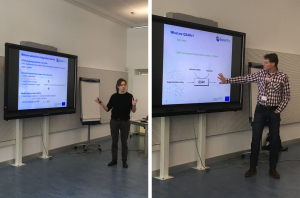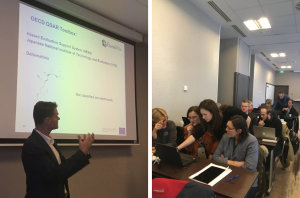
Multiple route exposure to multiple chemicals, the cocktail effect
EuroMix activities were presented at the International Society of Exposure Science (ISES) 2016 Annual Meeting in Utrecht, NL, October 9-13, 2016.
Four members of the EuroMix consortium presented results from Work Package 5 (aggregated and cumulative exposure assessment). The theme of the symposium was to explain the development of an efficient test strategy for mixtures
of potentially large groups of chemicals, which is practical yet general enough to account for multiple classes of compounds and diverse exposure pathways. A large set of compounds defined as a Cumulative Assessment Group
(GAG) for a given health effect can be reduced to a much smaller subset by considering the combinations of compounds that populations are actually exposed to. The talks included real examples currently being developed within
the project and demonstrated practical implementation in the Monte Carlo Risk Assessment (MCRA) software. Overall the message from these presentations was that EuroMix is developing a flexible and practical system that
can also build on, and link to, work developed in external models and link to external data collection.
Corinne Sprong (RIVM) was the first speaker and introduced the general concepts and motivation for developing a new system for mixture testing. Corinne also provided details of the practical implementation in MCRA and the mixture
selection from a dietary source.

Marc Kennedy (Fera) introduced the additional methods being used to incorporate non-dietary sources of exposure, which can also involve multiple compounds. Examples were presented combining the Browse software (EU FP7 grant 265307) with UK pesticide usage data to generate exposure distributions associated with the resident or operator population. The generated files were subsequently used as an input to MCRA.

Cecile Karrer (ETHZ) continued with a different example of non-dietary exposure (Bisphenol A), showing the flexibility of the EuroMix approach. Multiple sources were considered including consumer products (e.g. cosmetics/personal
care) with exposures calculated using the PACEM model, together with other sources (thermal paper, dust and air). This example demonstrated the ability to incorporate different classes of compounds and to generate uncertainty
realisations.

Amélie Crepet (Anses) finished the session with a detailed explanation of the methods and examples of the EuroMix strategy to identify important mixtures based on an exposure driven approach. These could then be prioritised
for toxicological mixture testing. PBPK models to aggregate exposures and link external with internal exposures were also explained. The examples presented are illustrative of the concepts and are not intended as real risk
assessments. With further data collection and software improvements, more detailed and complete case studies will be presented later in the project.

We would especially like to thank Bernadette Ossendorp for chairing the session.
here is the abstract book and for more information visit the ISES 2016 website.










